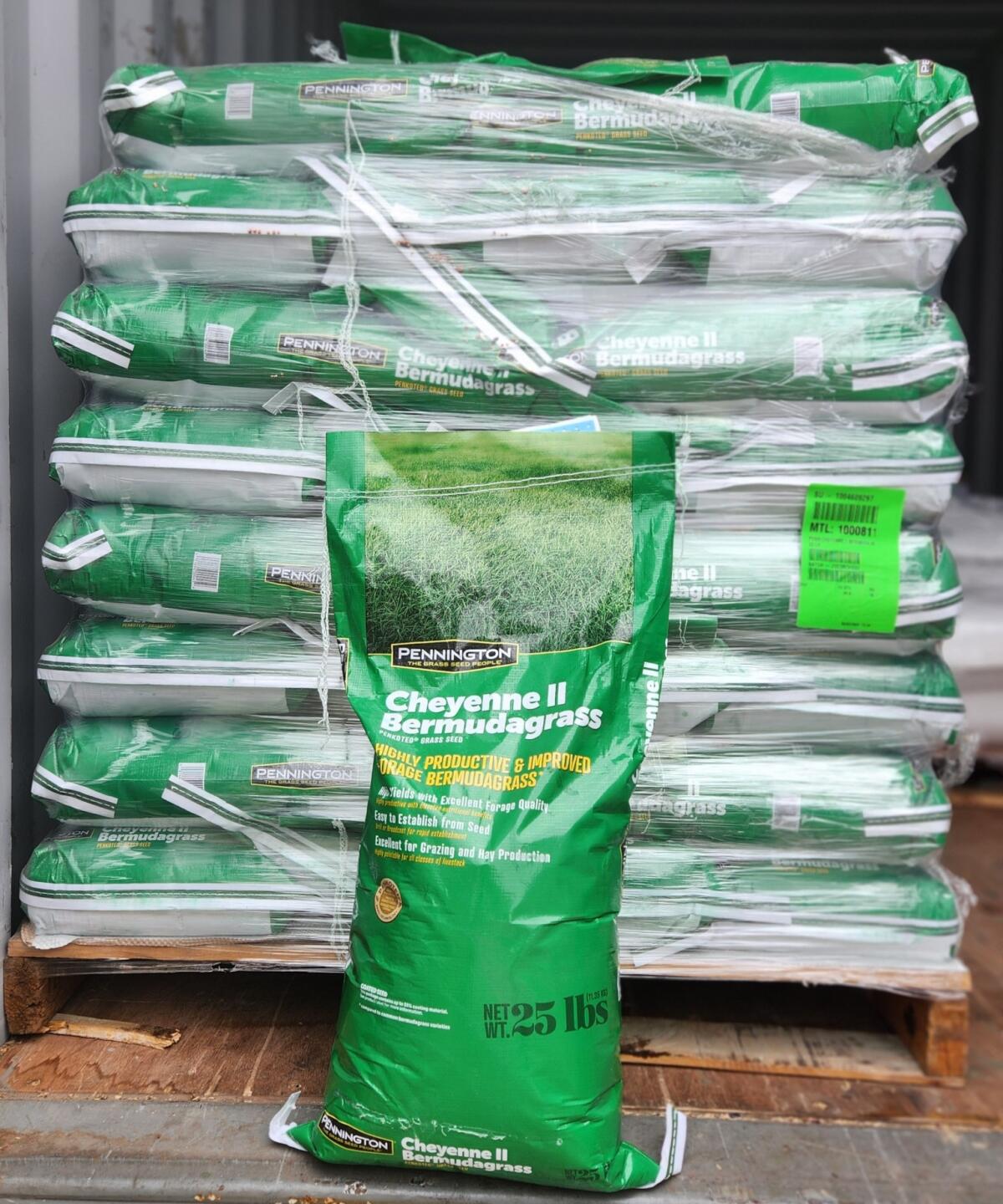Cynodon dactylon

Cheyenne II Bermudagrass

Cheyenne II Bermudagrass (25 Lb Bag)

Cheyenne II Bermudagrass (25 Lb Bag)
Cheyenne II Bermuda Grass grass seed
Perennial
Warm Season
Introduced
Seeded Variety
Cheyenne II Bermuda grass is an exclusive, certified hybrid variety of seeded bermudagrass developed through a cooperative relationship between Seeds West, Inc. and Texas A & M University. It is a single variety and not a bermudagrass blend. Cheyenne II provides high yields, outstanding palatability and excellent leafiness for use as pasture grazing or high quality hay production.a warm season, introduced, perennial grass used primarily for grazing and hay production. Cheyenne II Bermuda grass is a high quality grass excellent for horses and all other livestock.
Starter Fertilizer
Apply 25-35 lbs./acre nitrogen as a starter fertilizer at planting. Lime soil to a pH of 6.0 ? 6.5 and follow soil test recommendations for P & K.
Maintenance Fertilizer: (30-10-0)
is a typical fertilizer used to restore the nitrogen depletion during the grazing or baling process. Again, soil sample analysis can tell you more accurately what type on how much fertilizer you need.
Method:
Plant when soil moisture is adequate. For spring planting, delay seeding until soil temperatures average 65 degrees or higher at a 4 inch depth. For summer plantings, do not plant when ambient temperatures are expected to be above the middle 90?s. If weeds become problematic, mow the field periodically to reduce competition with the developing bermuda seedlings. To further reduce competition from weeds and grasses, delay the application of fertilizers containing nitrogen until the bermuda seedlings have fully emerged.
For Clean-tilled Ground ? Broadcast
? Prepare the ground well in advance. This allows the first flush of crabgrass and other weed competition to germinate and be killed by an application of a non-residual and non-selective herbicide like glyphosate before planting Tierra Verde.
? Clean-till the area with a disc, then level and smooth the area. Use a culti-packer to prepare a firm seedbed before planting. Several passes may be necessary to achieve proper firmness.
? Broadcast the seed and culti-pack once more to get good seed to soil contact. Bermudagrass
seed will not germinate in a fluffy, loose seedbed.
For No-Till Drill
? Take added precaution to ensure seed are not dropping too deep; 1/8″or less is ideal. One method to prevent deep planting is to pull the drill?s drop tubes out of the openers and let the seed fall behind the opener to be pressed into the loosened soil by the press wheel.
? Ensure that existing residue is not too thick for seedlings to emerge and that the seed is making good soil contact beneath the residue.
To Thicken Existing Stands
If seed are to be broadcast, loosen the soil surface in the bare areas prior to seeding by scratching with a finger drag or by light disking. After seed are broadcasted, use a culti-packer or similar roller device to press the seed into the soil and to firm the ground. If using a no-till drill, see instructions for No-Till Drill.
Management:
Once plants begin to spread, apply 50-60 lbs. of nitrogen per acre. Delay grazing or hay cutting until forage is 6? to 8? tall. Do not graze or clip for hay shorter than 2?. After the stand is established, apply 50-75 lbs. of nitrogen per acre for each cutting of hay. If grazed, apply up to 150 lbs. /acre N annually in split applications beginning at spring green-up and again during summer. To help prevent winter injury, the last nitrogen fertilizer application each year should not be applied less than 6 to 8 weeks before a killing frost. Maintaining medium to high levels of phosphorus and potassium in the soil throughout the growing season is key to disease prevention and bermuda stand survival. If season ending soil levels are low, apply phosphorus and/or potassium fertilizer per soil test recommendation in late summer/early fall to help prevent winter injury. When grazed, rotate animals more often during periods of drought stress. Do not graze forage below a height of 1.5- 2?.
Special Note: In first year bermuda, leave at least 4? of growth entering winter. Late cuttings of hay (6-8 weeks before a killing frost) and/or overseeding of winter annuals can weaken and potentially thin the stand. Once the bermuda is well established (2nd year and older stands), overseeding of winter annuals is acceptable.
